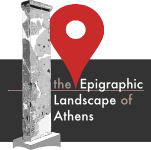Imposing statue base for Eumenes II reused for Agrippa ("Agrippa's monument")
ELA id: 408
View as PDFIG 2[2] 4122Inscriptiones Graecae II et III: Inscriptiones Atticae Euclidis anno posteriores (2nd ed., Pars I-III, Berlin 1913-1940; Pars V: Berlin 2008), Ed. J. Kirchner
Inv. number
PHI
Translations
AIO, AXON, IG Online
Images
Aleshire, Imaging Inscriptions, OSU Squeeze Collection, UBC Epigraphic Squeezes, ASCSA Net
Description
Date
ca. 17-13 BCE
Period: 1st century BCE --> late --> 27-1: Augustan age
Reasons: historical context, prosopography
See notesThe inscription dates to some time after the third consulship of Agrippa (27 BCE) and is probably to be related with the dedication by Agrippa of the Odeion at the center of the Agora in the winter 16/5 BCE. Agrippa was engaged in the eastern provinces between 23 and 21 and from 17 until 13 BCE.
Text category
honorific dedication (tabula honoraria)
✓overwriting
See notesDedication by the Demos to Marcus Agrippa, benefactor of the Athenians, after his third consulship of 27 BCE.
The text has been engraved on a surface roughened by the erasure of the earlier inscribed surface bearing a dedication to the king Eumenes II of Pergamon (on the erasure see Dinsmoor, AJA 24, 1920, 83American Journal of Archaeology, 1885-).
Monument description
Monument type: pillar-shaped base
Material: Hymettian marble
Original dimensions: h: ca. 13.40 (4.50 foundation, 8.91 shaft) * w: 3.31 * t: 3.80
✓ornamentation
See notesTall rectangular pedestal supporting a bronze four-horse chariot monument of Eumenes II dating to 186, 182 or 178 BCE, when Eumenes and his brothers won the Panathenaic chariot race, and later rededicated for Agrippa. The monument is today universally recognised as "Agrippa's monument". The inscription decorates the middle portion of the western front of the base, being thus visible on the left by everyone climbing the stairs to the Propylaia and the Parthenon. The chariot monument also looked west. The architectural forms and structure of the pedestal are still those of the first monument for Euemenes. On the top surface of the plinth hoof cuttings for different groups of horses are preserved (Korres 2000 317 εικ. 27Korres M., «Αναθηματικά και τιμητικά τέθριππα στην Αθήνα και τους Δελφούς», in Jacquemin A. (éd. par), «Delphes cent ans après la Grande fouille. Essai de bilan. Actes du colloque organisé par l’EFA, 17-20 septembre 1992», (BCH Suppl. 36), Athènes 2000, 293-329.): they reveal three different stages of use for the monument, one of which certainly dates back to the Pergamene period and another to Agrippa's age. The third intermediate stage is perhaps to be identified with a chariot monument of Antony and Cleopatra.
The base and inscription suffered some damages at the time of the siege by the Venetians in 1687. This is probably why some letters of the text are no more legible.
See Dinsmoor, AJA 24, 1920, 83American Journal of Archaeology, 1885-; Bringmann - von Steuben 1995 447Bringmann K. - von Steuben H. (hrsg.), «Schenkungen hellenistischer Herrscher an griechische Städte und Heiligtümer. Teil I: Zeugnisse und Kommentare», Berlin 1995.; Baldassarri 1998 247-249P. Baldassarri, «Σεβαστῶι Σωτῆρι. Edilizia monumentale ad Atene durante il Saeculum Augustum», Roma 1998; Korres 2000 314-319Korres M., «Αναθηματικά και τιμητικά τέθριππα στην Αθήνα και τους Δελφούς», in Jacquemin A. (éd. par), «Delphes cent ans après la Grande fouille. Essai de bilan. Actes du colloque organisé par l’EFA, 17-20 septembre 1992», (BCH Suppl. 36), Athènes 2000, 293-329.; Kotsidu 2000 Kno. 32[A]Kotsidu H. (2000), «ΤΙΜΕ ΚΑΙ ΔΟΞΑ. Ehrungen für hellenistische Herrscher im griechischen Mutterland und in Kleinasien unter besonderer Breücksichtigung der archäologischen Denkmäler», Berlin 2000; Topografia di Atene, 1 78, 80E. Greco (a cura di), «Topografia di Atene. Sviluppo urbano e monumenti dalle origini al III sec. a.C.», Tomo 1: «Acropoli - Areopago - Tra Acropoli e Pnice», Atene-Paestum 2015 (Monaco).
Photo of the pedestal in Travlos 1971 493 fig. 622Travlos J., «Bildlexikon zur Topographie des antiken Athen», Tübingen 1971; Baldassarri 1998 tav. LVIIIP. Baldassarri, «Σεβαστῶι Σωτῆρι. Edilizia monumentale ad Atene durante il Saeculum Augustum», Roma 1998; Kotsidu 2000 Abb. 1Kotsidu H. (2000), «ΤΙΜΕ ΚΑΙ ΔΟΞΑ. Ehrungen für hellenistische Herrscher im griechischen Mutterland und in Kleinasien unter besonderer Breücksichtigung der archäologischen Denkmäler», Berlin 2000;Krumeich - Witschel 2010 Taff. 8 (Abb. 14), 48 (fig. 2)Krumeich R., Witschel Ch. (hrsg.),«Die Akropolis von Athen im Hellenismus und in der römischer Kaiserzeit», Wiesbaden 2010.; reconstruction of the monument in Krumeich - Witschel 2010 Taf. 73 (Abb. 28)Krumeich R., Witschel Ch. (hrsg.),«Die Akropolis von Athen im Hellenismus und in der römischer Kaiserzeit», Wiesbaden 2010..
Drawing of the top surface in Korres 2000 315 εικ. 26Korres M., «Αναθηματικά και τιμητικά τέθριππα στην Αθήνα και τους Δελφούς», in Jacquemin A. (éd. par), «Delphes cent ans après la Grande fouille. Essai de bilan. Actes du colloque organisé par l’EFA, 17-20 septembre 1992», (BCH Suppl. 36), Athènes 2000, 293-329.; Kotsidu 2000 Abb. 2Kotsidu H. (2000), «ΤΙΜΕ ΚΑΙ ΔΟΞΑ. Ehrungen für hellenistische Herrscher im griechischen Mutterland und in Kleinasien unter besonderer Breücksichtigung der archäologischen Denkmäler», Berlin 2000.
Physical features
Measurements: h: 8.91 (inscribed front) * w: 3.31 * t: 3.80
State of conservation: The entire base is very well preserved
Legibility: Good. Five lines of text
Reuse: Reused "in situ"
Signs of reuse: Erasure and overwriting
See notesThe lettering is larger than that of the earlier inscription for Eumenes.
Findspot
✓in situ
Visible in front of the Propylaia from Antiquity
Chandler, Inscr.Ant. 14 (pars II, p. 52)Inscriptiones antiquae, pleraque nondum editae: in Asia Minore et Graecia, praesertim Athenis collectae. Ed. R. Chandler (Oxford 1774) = CIG 1 309Corpus Inscriptionum Graecarum (A. Boeck), I vol., Berlin 1828 = IG 3 575Inscriptiones Graecae III: Inscriptiones Atticae aetatis Romanae. (Voll. I-II, Berlin 1878-1882). Ed. G. Dittenberger
Original location
The base lies on the northern terrace in front of the Propylaia, on a lower level than the Pinakotheke (northwest wing of the Propylaia)
For the position of this imposing base cf. Travlos 1971 487 fig. 614Travlos J., «Bildlexikon zur Topographie des antiken Athen», Tübingen 1971; Bringmann - von Steuben 1995 Plan 1, no. 3Bringmann K. - von Steuben H. (hrsg.), «Schenkungen hellenistischer Herrscher an griechische Städte und Heiligtümer. Teil I: Zeugnisse und Kommentare», Berlin 1995.; Krumeich - Witschel 2010 Taff. 3 (Abb. 5), 4 (Abb. 6), 5 (Abb. 7), 81 (B1)Krumeich R., Witschel Ch. (hrsg.),«Die Akropolis von Athen im Hellenismus und in der römischer Kaiserzeit», Wiesbaden 2010.


